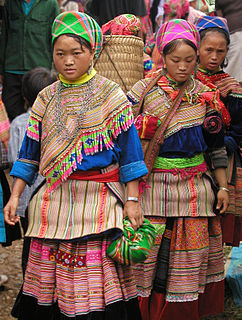
The Hmong people are an ethnic group in East and Southeast Asia. They are a sub-group of the Miao people, and live mainly in Southern China, Vietnam and Laos. Some Hmong have emigrated to the United States.

The Miao is an ethnic group belonging to South China, and is recognized by the government of China as one of the 55 official minority groups. Miao is a Chinese term and does not reflect the self-designations of the component groups of people, which include Hmong, Hmub, Xong (Qo-Xiong), and A-Hmao.

The Hmong–Mien languages are a highly tonal language family of southern China and northern Southeast Asia. They are spoken in mountainous areas of southern China, including Guizhou, Hunan, Yunnan, Sichuan, Guangxi, and Hubei provinces, where its speakers have been relegated to being "hill people", whereas the neighboring Han Chinese have settled the more fertile river valleys.
The She language, autonym Ho Ne or Ho Nte, is an endangered Hmong–Mien language spoken by the She people. Most of the over 709,000 She people today speak Hakka Chinese. Those who still speak She—approximately 1,200 individuals in Guangdong province—call themselves Ho Ne "mountain people". She is nearly extinct today.
A macrolanguage is a book-keeping mechanism for the ISO 639 international standard for language codes. Macrolanguages are established to assist mapping between different sets of ISO language codes. Specifically, there may be a many-to-one correspondence between ISO 639-3, intended to identify all the thousands of languages of the world, and either of two other sets, ISO 639-1, established to identify languages in computer systems, and ISO 639-2, which encodes a few hundred languages for library cataloguing and bibliographic purposes. When such many-to-one ISO 639-2 codes are included in an ISO 639-3 context, they are called "macrolanguages" to distinguish them from the corresponding individual languages of ISO 639-3. According to the ISO,
Some existing code elements in ISO 639-2, and the corresponding code elements in ISO 639-1, are designated in those parts of ISO 639 as individual language code elements, yet are in a one-to-many relationship with individual language code elements in [ISO 639-3]. For purposes of [ISO 639-3], they are considered to be macrolanguage code elements.
A-Hmao are an ethnic group in China. They are from Yunnan and Sichuan. They also live in Guizhou. The number of persons within this group likely exceeds 400,000. Their language belongs to the Hmong family.
Small Flowery Miao is a Miao language of China that is closely related to Hmong: Hmong and Small Flowery Miao are listed as the first and second local dialects of the Chuanqiandian Cluster of West Hmongic languages. It is spoken in Nayong, Shuicheng, Zhenning, Guanling, and Hezhang counties of western Guizhou, China.

The Hmongic also known as Miao languages include the various languages spoken by the Miao people, Pa-Hng, and the "Bunu" languages used by non-Mien-speaking Yao people.
The Then language is a Kam–Sui language spoken in Pingtang County, southern Guizhou. It is spoken by the Yanghuang 佯僙 people, many of whom are officially classified as Maonan by the Chinese government.

The Proto-Hmong–Mien language is the reconstructed ancestor of the Hmong–Mien languages.
Mün is a Kuki-Chin language of Burma. It is spoken in Mindat township, Chin State, and Saw and Tilin townships, both in Magway Region (Ethnologue).
The A-Hmao language, also known as Large Flowery Miao or Northeast Yunnan Miao, is a Hmongic language spoken in China. It is the language the Pollard script was designed for, and displays extensive tone sandhi. There is a high degree of literacy in Pollard among the older generation.
The West Hmongic languages, also known as Chuanqiandian Miao and Western Miao, is the major branch of the Hmongic languages of China and Southeast Asia.
Hm Nai is a Hmong-Mien language spoken in western Hunan province, China. There are approximately 5800 people speaking this language, and the number is decreasing. Mao & Li (1997) determined it to be closely related to the Pa-Hng language.
Luobohe Miao, a.k.a. Hmjo or A-Hmyo, is a Miao language of China.
Guiyang Miao, also known as Guiyang Hmong, is a Miao language of China. It is named after Guiyang County, Guizhou, though not all varieties are spoken there. The endonym is Hmong, a name it shares with the Hmong language.
Mang, or Mashan Miao also known as Mashan Hmong, is a Miao language of China. The endonym is Mang, similar to other West Hmongic languages such as Mong.
Ná-Meo is a language of northern Vietnam, spoken by the Mieu people. Nguyen (2007) believes Na Meo may be a Hmongic language closest to Qiandong Miao.



